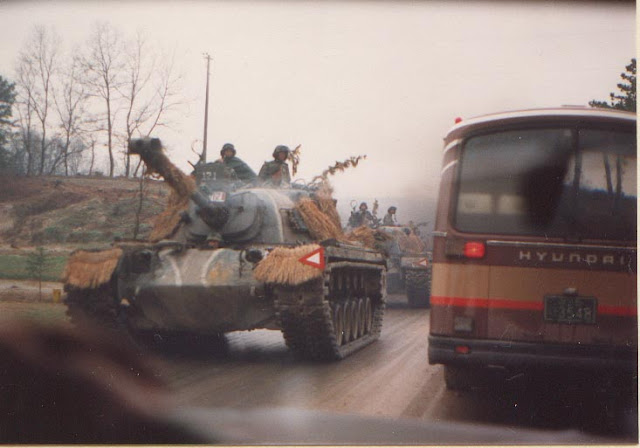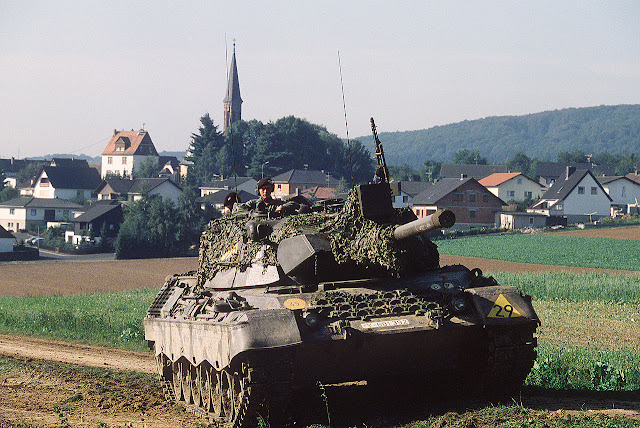Turkey is not a wealthy nation. It has a really good army, but the quality of that army is in its fighting men (and they are men) and its culture. The Ottoman army performed badly in World War One, but that was mostly due to its poor officer corps, a reflection on the decrepit nature of the Ottoman leadership in general. Well lead, on occasion they were, they preformed very well. The Allied defeat at Gallipoli provides plenty evidence of that. And following the fall of the Ottomans the Turkish army certainly proved itself capable of besting the Greeks and troubling the British and French.
The Turkey that was born out of the fall of the Ottoman Empire sat World War Two out, as we've noted previously, although technically it became an Allied power in February, 1945, when it belatedly declared war on Germany. That declaration didn't mean anything militarily, it merely served to put Turkey on the winning side which, given its hostility to the Soviet Union, was a wise diplomatic move. Turkey did see action in the Korean War, however, where its troops performed brilliantly. There's no doubt that Turkey has a good army and its soldiers are excellent.

Turkish soldiers memorial in South Korea.
Since the Korean War the only action that the Turkish army has seen has been in Cyprus in 1974, an event that almost resulted in a full scale old fashioned territorial war between Greece and Turkey, two NATO members. That fortunately didn't develop, but there's little doubt which of the two armies was more capable. Other than that, the Turkish army has seen action only against Kurdish militias, which is a different type of war.
For that matter, Kurdish militias are very good at what they do as well, which has traditionally been guerrilla warfare. More recently, in Iraq and Syria, they've filled the roll of light infantry, but that's really what they are at best. They don't have the capabilities to take on an armored regular army like Turkey's.
But in saying all of that, the oddity, as noted, is that the equipment in evidence is strangely like watching an army from the 1980s, or even the 1970s. For those who follow military equipment, as we've stated, it's oddly fascinating.
Turkey uses armor, and it deploys it in all such actions as we are seeing. On the television news there's been scene after scene of the Turkish army unloading tanks for deployment. The tanks they keep showing are M60s.
Turkey's main tank is the M60, of which it has about 1,000. The M60 was an excellent tank, but it was already on its way out of US Army service (it hung around in the Marine Corps longer) when I was a Guardsmen in the 80s.
The second most common Turkish tank is the US M48. The U.S. used the M48 heavily in the Vietnam War, at which time M60s were already coming on (no need to use the best tank in an environment in which tank to tank combat is unlikely). The M48 was a really good tank, but its a bit odd to see them still in a "western" nation's front line service.
M48 Patton

South Korean Army M48, March 1987.
The third US tank in a row to be named in honor of Gen. Patton, the M48 featured the new familiar Pershing chassis but omitted the bow machinegun, the first main U.S. tank to make that omission. It was in fact an entirely new design, obviously based on the old M26 lineage, and was an enormously successful tank.
M48 Patton in South Vietnam.
The M48 would be the principal US tank in the late 1950s and go on to see heavy use by the US and its allies for many years. It was the tank the US principally used in Vietnam. The last variant of it, the M48A5, was sufficiently close to its successor, the M60, that it was up-gunned to the 105mm gun the M60 used and it can be very difficult to tell the two apart. Indeed, the M48A5s actually replaced the M60 in service with the US Army and South Korean army in Korea in the late 1970s, showing how close they really were.
M48A5, equipped with a 105mm gun and much resembling its successor, the M60.
The Turks use smaller numbers of the GERman Leopard 1 and 2.
The Leopard I
The Leopard I? That's a post war German tank.
The Leopard I? That's a post war German tank.
Later variants of the Leopard I in Germany. This one has been up armored. The original Leopard Is were fairly lightly armored. Let's see, six wheels that look remarkably like the six on all of the Pershing descendants. .. rear sprocket drive like the Pershing and its descendants, roller wheels to support the treads up on top (not visible here. . . . hmmm.
Yep, it is.
Inclusion of the Leopard I here is going to make its fans angry, but the Leopard I resembles the M48 more than it does any German tank of World War Two, something that isn't true of all post war German equipment.
One of the most famous of the post war tanks, the Leopard I came in after West Germany had been equipped with M47s and M48s. Wanting to field its own design, West Germany first worked with France to come up with a tank design and then abandoned the pursuit. Going on its own, it came up with the Leopard I.
Earlier variant of the Leopard I with a cast turret that looks remarkably like that on a M46/M47/M48.
You will not be able to find (or at least I couldn't) anything that will claim that the Leopard I was based on part on the Pershing tank chassis and the M47 and M48 tanks. But the similarities are remarkable. Most notably the chassis is nearly identical. something that departed enormously from all prior German tanks. The original turrets were also remarkably like those of the period M48s. Perhaps, just perhaps, there was no influence, but that would certainly counter they way they looked at the time of their introduction.
The Leopard 2 is still a front line tank in many armies and the last German tank to be introduced. It's a contemporary design to the M1 Abrams. The Turks have about 350 of them, about the same number as Leopard 1s. While I can't say, I'd be surprised if they deployed them in Syria for the same reason that its not surprising that we didn't deploy M60s to Vietnam. No reason to send in your most modern tank where its not going to encounter another tank.
The Turks are currently building their own tanks, but they just started. The Altay Turkish tank reflects a global trend of nations once again building their own armor, rather than importing it, a return to past practices. The Altay is based on the South Korean K2 Black Panther, which also reflect that trend. But the Altay just entered service.
Reliance on German weapons is something that the Turks have done since the Ottoman days. At some point Turkey ceased to be an international weapons shopper when it was still the Ottoman Empire and became a German client. For that reason it fought World War One with German designs. In the Interbellum it still used them, and when the Germans took Poland in 1939 the Turks took quite a few unfinished Polish 98 Mausers and finished them themselves.
After World War Two the Germans were briefly out of the weapons business, but when they returend to it Turkey returned as a customer of its small arms. While Turkey has a vareity of odds and ends in small numbers, the G3 and the MG3 are its main infantry squad weapons. If you see a Turkish soldier armed with something else, there's a reason for it. Both are excellent weapons and ideal for the conditions they're being used in. Both date back quite some time now, although neither could be considered obsolete. Only in pistols does Turkey really depart from pattern here, using a locally produced variant of the Baretta 92F, which of course itself is based on the Walther P-38.
Artillery wise, Turkey uses a smattering of things, but those things include a lot of Cold War era American artillery pieces, including the M110, which is something I'm pretty familiar with from my earlier days.

The M110.
Aircraft wise, Turkey has been an American customer and its primary combat aircraft is the F16, made under license in Turkey. Turkey was going to buy F35s, but a purchase of Russian anti aircraft missiles caused the US to cancel the deal. This in fact has been emblematic of recent problems between the US and Turkey, as Turkey has flirted with looking East after the US pretty much ignored the problems created by Turkey shooting down a Russian airplane flying out of Syria awhile back.
I frankly doubt Turkey will continue to look east. .. in that fashion. There's a huge Central Asian Turkish population to Turkey's east and Turkey can't ignore that and Russia is unlikely to do so.
Turkey also isn't ignoring the Kurds, of course, which gives us the reason for the current Turkish offensive in northern Syria, an action which the Syrian government is taking advantage of, and that takes us to the Kurds.
Kurdish combatants have long been users of the AKM, which people commonly imagine to be the AK47. This is a remnant of the days in which the various Kurdish militias fell on the leftward side of the Cold War map and therefore were entitled to Soviet aid, one way or another. The Kurds, as a result, are heavy users of old Soviet weapons.
More recently they've benefited from American and German assistance so they have a variety of old and new weapons. From the US they've acquired M4 carbines, and from Germany G3s and G36s. They possess anti tank missiles as well, but in terms of heavy weapons, they are lacking.
All of which goes to make the current fighting between the Turks and the Kurds, in which the Kurds will give a good account of themselves but lose, an odd late Cold War feel to it.
I frankly doubt Turkey will continue to look east. .. in that fashion. There's a huge Central Asian Turkish population to Turkey's east and Turkey can't ignore that and Russia is unlikely to do so.
Turkey also isn't ignoring the Kurds, of course, which gives us the reason for the current Turkish offensive in northern Syria, an action which the Syrian government is taking advantage of, and that takes us to the Kurds.
Kurdish combatants have long been users of the AKM, which people commonly imagine to be the AK47. This is a remnant of the days in which the various Kurdish militias fell on the leftward side of the Cold War map and therefore were entitled to Soviet aid, one way or another. The Kurds, as a result, are heavy users of old Soviet weapons.
More recently they've benefited from American and German assistance so they have a variety of old and new weapons. From the US they've acquired M4 carbines, and from Germany G3s and G36s. They possess anti tank missiles as well, but in terms of heavy weapons, they are lacking.
All of which goes to make the current fighting between the Turks and the Kurds, in which the Kurds will give a good account of themselves but lose, an odd late Cold War feel to it.







No comments:
Post a Comment